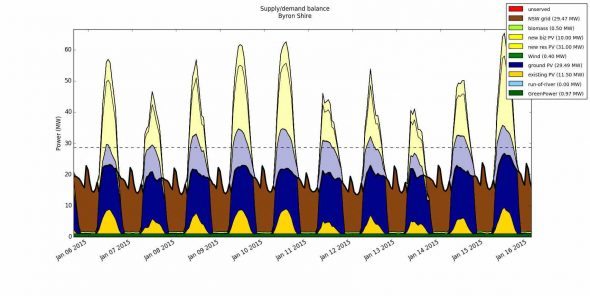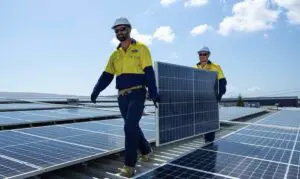It is well known that renewable energy projects have significant environmental benefits, but they also have significant local social benefits that are often overlooked, especially for regional areas.
These include:
- Direct local employment creation and skills development: through the construction and operation of renewable energy businesses and projects (and often through the provision of complementary energy efficiency services).
- Indirect employment creation: by reducing the amount of money that leaves regional areas through the generation component of electricity bills, which is in the order of 10s of millions of dollars per year. Local generation of electricity keeps this money in the area, which can then circulate through the local economy with a multiplier effect to create local employment.
- Local resilience: at the household or business level by enabling ride-through of brown outs and blackouts, with the potential for the creation of semi-autonomous embedded networks, where entire regions can stay electrified.
There is a clear role for local governments – not only to facilitate the uptake of smaller-scale renewable energy and energy efficiency, but also to guide this in order to maximise local benefits, such as employment creation.
ITP Renewables has recently undertaken work for Zero Emissions Byron, (funded by Byron Shire Council), which has a stated aim of reaching zero emissions (and 100% renewable electricity) by 2025. This work is broken down into three components:
- Hourly modeling to identify least-cost technology options,
- Identification of high level issues that need to be addressed, and
- The development of a ‘toolbox’ of policies, programs and processes required to drive uptake and maximize local benefits.
Modeling
After allowing for the current levels of renewables, the NEMO (National Electricity Market Optimiser) model was used to optimise for least-cost through scenario analysis of likely options. This produced charts such as the following for a 100% renewable electricity outcome (on an annual basis, meaning that the total electricity use over the year is matched by an equivalent amount of renewable generation), which highlights the major role for solar in the Byron region.

It also illustrates the impact of very high levels of penetration of solar. The brown area (and the black line cutting through the blue area) is the underlying load, and so every day significant amounts of electricity would be exported back through the zone substations, then every night it would be imported back again.
This not only highlights the importance of storage to soak up daytime supply, but the need to reduce night-time loads and shift them to the day.
High-level issues
One of the main drivers for regional communities getting behind renewables is to make a difference in reducing greenhouse gas emissions. Many communities seek to ensure that their actions are additional to existing policy measures.
To do this, all renewable energy systems have to be less than 100kW (and so avoid the use of LGCs) or, if greater than 100kW, then not allow the generated LGCs to be used to meet compliance targets. This of course, increases costs.
Another driver is the desire for social outcomes, such as those discussed above, which means that renewable energy systems should be built locally, and not necessarily only in regions with the highest solar or wind resources.
Another driver is financial ownership by the local community, which also maximises local social benefits.
This all points to a significant role for local governments in not only promoting local renewables, but in coordinating the required policies, programs and processes.
Policies, programs and processes
There is a tendency to focus solely on policies that can drive uptake, however, a suite of measures is the most effective. There is a need for measures which:
- drive higher uptake (eg. feed-in tariffs, energy efficiency requirements, information provision)
- enable higher uptake (eg. connection standards, training, solar access rights), and
- deal with the consequences of a higher level of uptake (eg. new technical requirements, new regulatory frameworks or operational models for network operators).
A ‘toolkit’ of appropriate policies was developed for this project. Some of these policies are under the jurisdiction of local government, and even for those that are not, local government still has a coordination role. The aim is to not only create an environment where the private sector[1] wishes to invest in renewable energy and enabling technologies (such as batteries, metering devices etc), but to maximise the resulting local social benefits.
Byron Shire Council, Zero Emissions Byron, Enova Community Energy and Community-Owned Renewable Energy Mullumbimby are working together to develop and implement a roadmap of policies to achieve Byron’s 100% renewable electricity goal. ITP Renewables is currently undertaking similar work for East Gippsland Shire Council and will report on that project in due course.
[1] Here the ‘private sector’ refers to any non-government entity, and so includes individuals, community groups, educational institutions, businesses etc.
This article was written by Rob Passey and Ben Elliston. Reproduced with permission.







